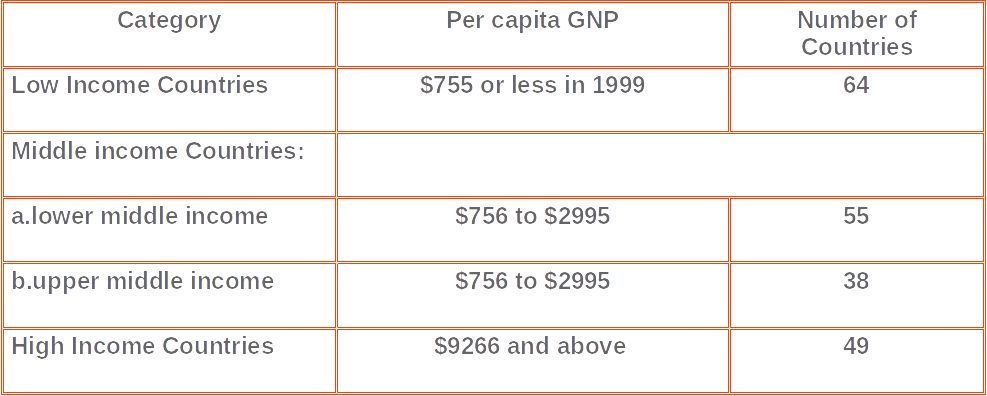Economic development can also be seen as a level of economic attainment. Measurement and comparison of development require indicators of development. We can discuss four important indicators of development. These four indicators are: Per capita income, Physical Quality of Life Index, Human Development Index and Quality Life Index.
Per capita Income: The value of output produced by an economy in a year is indicated by the gross domestic product (GDP). However, the GDP measures only the value of output produced with in the domestic territory of the country. Income received from abroad is not included in the GDP. If we add net factor income from abroad to the GDP , we get the gross national product (GNP). Therefore, we can say that GNP better represents the entitlements of the nationals of a country.Net value is a better measure of entitlements than gross value. Net value is derived by deducting depreciation from gross value. Depreciation refers to the capital consumption expenses. In other words, depreciation is the capital that is consumed during the process of production. Therefore, if we deduct depreciation from GNP we get NNP. NNP can be represented either in market price (NNPMP) or in factor cost (NNPFC). NNPFC is the true indicator of an economy’s entitlements. NNPFC is also known as the national income.
Concepts like the GDP, GNP and NNP reflect the size of the economy. These concepts do not reflect the purchasing power of the people. Purchasing power of the people and their standard of living are better reflected by the per capita income. Per capita income is the income per head of population. Per capita income is calculated by dividing the national income (NNPFC) by the size of the population.Comparison between per capita income can be highly informative. Comparison of India’s per capita income in 1975 with her per capita income in 2002 will give us an idea about the levels of development at these two points of time. Similarily, comparison of the per capita incomes of different countries will help us to understand their levels of development. comparison of India’s per capita income with that of the USA and Somalia will help us understand the level of India’s development in relation to that of the USA and Somalia.
Per capita income is an important indicator in the classification of economies into high income, middle income and low income economies. The world development report (2000-01) published by the World Bank classifies the economies of the world in to three categories based on their per capita GNP. This is shown in table below.
- Distribution of national income also has to be considered along with per capita income. If income is more equally distributed, welfare will improve.
- People value leisure. National income and per capita income will be realistic indicators only if the value of leisure is also incorporated in national income.
- Social costs like the cost of pollution have to be deducted from national income to make national income and per capita income figures more realistic.
Alternative measures an evaluation:
Even after incorporating some corrections and improvements, per capita income as an indicator of development continued to suffer from deficiencies. In recent times some attempts have been made to develop alternative indicators of welfare and social development.
You might have read in medias about the ‘Kerala Model’ of development. What is this ‘Kerala model’ or ‘Kerala experience’ ? Kerala has achieved very high level of social development. This remarkable achievement in social development is reflected in high life expectancy, high literacy, high level of female literacy and gender justice, low rates of birth, low rates of death, low infant mortality, low maternal mortality, etc. What makes the Kerala experience unique is the fact that these high levels of social development have been achieved with low economic growth and low per capita state income. There are controversies regarding the sustainability of the so called Kerala model. But the fact that our own state have achieved such high levels of social development is remarkable.
The fact that factors other than per capita income contribute to development and welfare, led researchers to look for alternative indicators. The United Nations Research Institute for Social Development (UNRISD) tried to develop indices incorporating social, economic and political variables. UNRISD selected 16 indicators included life expectancy, combined primary and secondary enrolment, average number of persons per room, news paper circulation for 1000 population, per capita electricity and steel consumption, percentage of GDP derived from manufacturing, etc. UNRISD efforts did not produce a meaningful indicator of development. This led to attempts to develop a composite index of development. The result was the development of some quality of life indices.
Quality of Life Indices:
We already discussed briefly the constituents of quality of life like life expectancy, health, literacy, environment, etc. Based on these norms, indices of quality of life have been constructed. We shall discuss two important indices likE PQLI and HDI.
Physical Quality of Life Index:
PQLI was developed by Morris David Morris. D Morris found that the parameters used by UNRISD and many development economists were inputs to development rather than output of development. For example, enrolment in schools is an input while literacy is an output; health facility is an input while life expectancy is an output. The deficiency of this approach is that it assumed only one path to development and that is the path followed by the developed western economies. The natural logical corollary of ths assumption was that if the developing countries have to achieve development they will have to follow the path taken by the developed countries. But the fact is that developing countries are characterized by wide diversities. It is possible to achieve development through different means or approaches. Therefore, Morris David proposed a set of criteria for developing a complex index of development. This index was constructed using indicators that represented out put of development rather than inputs. Also, the indicators recognized the diversities among countries.
Choice of Indicators:
Morris David felt that the indicators chose should fulfil certain conditions. They should,
- Reflect output of development and not inputs.
- Recognize the diversities among countries.
- Be simple to construct and easy to understand.
- Be capable of making international comparison.
Morris found that there are only three indicators which fulfil these conditions. They are,
- Life Expectancy
- Infant mortality (death before age one)
- Basic literacy
These three indicators have universal acceptance.
It is important to note that life expectancy is expectancy at age one, not at birth. This is because, infant mortality (death before age one) is included as a separate indicator. LE, IM and BL are measured differently. Life expectancy is measured in terms of years, infant mortality in terms of per thousand and basic literacy in terms of percentage. Therefore, they cannot be simply added. For purpose of comparison, they have to be normalized. For each of the three indicators, Morris chose the most and the worst levels. Life expectancy and basic literacy are positive indicators. Therefore, the best is indicated by the maximum and the worst by the minimum. Infant mortality is a negative indicator. So the best is indicated by the minimum and the worst by the maximum. For converting the actual levels of LE and BL into normalized indicators, Morris first subtracted their minimum values from their actual values. Then the difference so obtained was divided by the range. (range is the difference between the maximum and the minimum values). This means for positive indicators of LE and BL:
Actual value – Minimum value
Achievement Level = Maximum value – Minimum value.
For infant mortality which is a negative indicator, first the actual value is subtracted from the maximum value and then the difference is divided by the range. This means, for IM:
Maximum value – Actual value
Actual value – Minimum value
Index construction:
Now, we have three indicators:1) Life Expectancy Indicator (LEI) 2)Infant Mortality Indicator (IMI) and 3) Basic Literacy Indicator (BLI). Averaging these three indicators, we get the Physical Quality of Life Index (PQLI).
PQLI = {⅓} (LEI+IMI+BLI)
Choice of Maximum and Minimum Values
For literacy level the natural maximum level is 100 and minimum is 0. there is no such natural maximum and minimum level for life expectancy and infant mortality. So Morris chose some reasonable values based on some calculations. The values that Morris chose are given in below table.
Maximum and minimum values of component indicators.
LEI = Actual life expectancy – 38 ÷ 39
IMI = 229 – Actual infant mortality rate ÷ 220
BLI= Actual literacy rate – 0 ÷ 100
By putting the actual values of a country in the above equations, we can construct the component indices and by dividing it by three, we can construct the PQLI for that country.
Let us try to apply this in the Indian context. Suppose the actuals for India are as follows:
Life expectancy at birth – 65 years.
Infant mortality rate – 60 per thousand.
Basic literacy rate – 60 percent.
Applying these actuals in the equations we find that LEI is 0.69. IMI is 0.76. and BLI is 0.60. The PQLI would be 0.68.
Human Development Index:
The HDI was developed by the United Nations Development Programme (UNDP). The UNDP has been publishing annually a Human Development Report since 1990. This report ranks countries on the on the basis of their human development index. The pioneering conceptualizer of the HDI and the HDR was the famous Pakistani economist Mehbub-ul-Haq.
Human development index is a composite of three variables, viz, longevity, knowledge and standard of living. These three variables are measured using different indicators. Longevity is measured in terms of life expectancy. Knowledge is measured in terms of education. Standard of living is measured by per capita income. HDI can be defined as an average of longevity knowledge and standard of living. To be more precise, HDI is an equi-weighted average of three indices, viz,
- Life expectancy Index (LEI).
- Educational Attainment Index (EAI).
- Standard of Living Index (SLI).
Averaging these three sub indices, we get the HDI.
HDI = (⅓) (LEI+EAI+SLI)
The sub indices are calculated using the same method used in the calculation of PQLI.
The three components as we have seen, are life expectancy, educational attainment and standard of living. Life expectancy here is life expectancy at birth, not at age one. This is because in HDI, unlike in PQLI, infant mortality is not an indicator.
Educational attainment is treated as literacy plus. Adult literacy alone can not capture educational attainment. Therefore literacy plus average years of schooling was used initially. Later average years of schooling was replaced by combined enrolment ratio. Thus educational attainment is now treated as adult literacy plus combined enrolment ratio. The weights given to adult literacy ratio (ALR) and combined enrolment ratio (CER) are ⅔ and ⅓ respectively. In other words, educational attainment index can be given by the equation.
![]()



